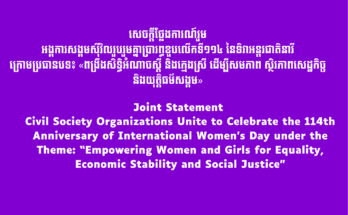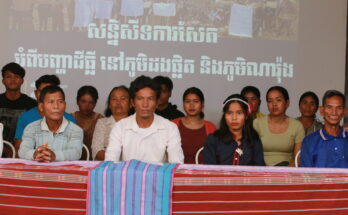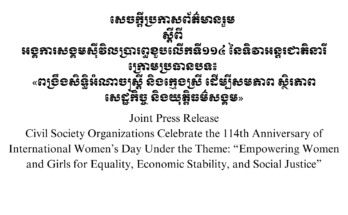Human Rights Defenders Mr Pen Bunnar and Mr. Chhay Thy are facing criminal charges at Rattanakiri Province Court
 As part of a growing trend whereby human rights defenders in Cambodia are facing criminal charges, two staff from the Cambodian Human Rights and Development Association (ADHOC), Mr Pen Bunnar and Mr Chhay Thy, and one Radio Free Asia (RFA) journalist, Mr Ratha Visal, appeared at Rattanakiri Provincial Court on 13th October 2011 for questioning related to accusations of incitement.
As part of a growing trend whereby human rights defenders in Cambodia are facing criminal charges, two staff from the Cambodian Human Rights and Development Association (ADHOC), Mr Pen Bunnar and Mr Chhay Thy, and one Radio Free Asia (RFA) journalist, Mr Ratha Visal, appeared at Rattanakiri Provincial Court on 13th October 2011 for questioning related to accusations of incitement.
The three men were accused by investigative Judge Thor Saron in 2009 after community members in Patang village allegedly took matters into their own hands in a land dispute with the D.M. Group. Villagers were believed to be responsible for burning down a bridge erected by the company and for destroying newly planted rubber trees. Judge Saron, who was subject to investigation by the Supreme Council of Magistracy in 2009 in relation to his handling of cases in Rattanakiri province, claimed that Visal, Thy and Bunnar had incited villagers to carry out these violent acts. There is no concrete evidence, however, either for the villagers committing these violent acts on company property, or for the three men in question inciting them to do so. Thinly veiled behind these accusations is a case of an economic land concession with close links to interests of the authorities, and yet another case of attempting to silence opposition through the judiciary.
There are many factors to this case that make it an interesting and complicated one. The bottom line however is the steadfast innocence of the three accused, who hope to have their names cleared after almost two years of uncertainty. Since 2009 Judge Saron has retired and been replaced my Mr Loch Lao. On Thursday 13 October Judge Loch questioned Ratha Visal, Chhay Thy and Pen Bunnar consecutively. Secure in their blamelessness, the three men appeared relatively unaffected in the period running up to the questioning. Mr Visal, who was first to meet with the judge, was asked three main questions. The first of these was in relation to motives of the villagers who burned the company bridge and cut down rubber trees. To this Mr Visal responded that he was not present at the village on the days these acts allegedly took place (22 and 23 November, 2008) and that as a journalist, he was only on the scene afterwards to ask questions and to compile a news report. The second question related to the role of Chhay Thy in relation to the villagers; Mr Visal explained that at the time Mr Thy was an ADHOC activist, not a staff member. He said that Mr Thy did not act as a trainer- he did not address the people as a group or advise them as a trainer or staff member would, and therefore he had little influence. He was Pen Bunnar’s assistant at the time, helping him to set up workshops and trainings and playing mainly an administrative role. The third question put to Visal concerned the activities of Mr Bunnar, the Provincial Coordinator for ADHOC in Rattanakiri. The judge wanted to know the details of Mr Bunnar’s activities within the communities. Mr Visal explained the activities of the ADHOC provincial coordinator and said that they were always within the law and concerning the law. Mr Visal specified that Bunnar trains people in their rights and that after every training Bunnar would stress the importance of non-violent action. He never advocated violence; in fact he firmly discouraged it.
Mr Visal brought with him three documents to present to the Judge: a United Nations definition of incitement and disinformation, a CCHR (Cambodian Centre for Human Rights) general statement on incitement and a document containing the fingerprints of the villagers from Patang testifying the innocence of the three men. He made a recommendation to the judge that he continue to investigate the case, especially from the point of view of the incidences of violence towards the company, as there had been no proof that the villagers had carried out these acts. He echoed the sentiment of all of the men in his hope that the case would be efficiently resolved and the truth would be reached. He simultaneously expressed hope that the charges against him and the two ADHOC staff would be dropped, as they had done nothing wrong and consistently acted within the law. An interesting piece of information raised by Judge Loch during his meeting with Mr Visal was that the three men had been placed under judicial supervision by the previous judge in accordance with article 223 of the Criminal Procedure Code 2007. The men had never been informed of this and therefore were not aware of the obligations that this provision placed upon them, for example restrictions on travel.
ADHOC monitor Mr Chhay Thy was next to be questioned by the judge and was accompanied by ADHOC lawyer Mr Long Lun. Mr Thy was questioned regarding his activities in the community and whether he had gone to sensitize the villagers before the violent acts occurred. Mr Thy responded that he had not. He explained that, at the time, he was an ADHOC activist, not an official member of staff. His role was to assist Mr Pen Bunnar, which consisted of mainly administrative tasks. He was not a speaker and did not have the type of contact with the people that would be necessary to incite violence. Mr Thy’s lawyer, as a fellow staff member was adept to describe ADHOC activities and policy. He stressed stress to the judge that ADHOC’s activities are strictly non-violent and that we only advocate peaceful means of achieving rights.
Mr Pen Bunnar, ADHOC Provincial Coordinator for Rattanakiri and the accused with the most influence in the communities, was last to meet with the judge. The first question the judge raised to Bunnar was on ADHOC activities in the province. Mr Bunnar explained that two main activities were carried out: seminars/trainings and investigations. Bunnar explained the background of the land case in question to the new judge. He outlined the beginning of the major conflict in 2007, when businessmen connected to the D.M. Group company, who had arranged with local authorities to buy land from five individuals for personal use in 2005, paid Commune and Village Chiefs to allow the D.M. Group to clear some of this land. When the company began to clear the land community members were incensed as they had not agreed to sell their land to anyone. In addition individuals were not legally permitted to sell the land, as it was collective commune property. Villagers brought their complaints to the ADHOC provincial office and Mr Bunnar began to investigate the case. The second question put to Mr Bunnar was related to the communications he had with villagers when they came to his office. Mr Bunnar explained that his role is one of a facilitator, not a lecturer. He informs people of their lawful rights and also creates opportunities for them to have contact with local authorities and other stakeholders. He noted that during trainings and workshops he would invite others to speak, for example representatives from provincial offices, governors, representatives from government departments and court officials. He told the Judge truthfully that before arranging a workshop he would always write a letter to authorities to outline workshop topics and objectives and to seek formal permission. Judge Loch explained that he was aware that judge Saron had written a letter to Pen Bunnar claiming that the violent acts were committed by villagers just several days after an ADHOC training. The new Judge therefore wanted to be very clear on ADHOC activities. At this point Mr Bunnar emphasised again the peaceful nature of ADHOC activities and the strict policy of non-violence.
Before being dismissed, Pen Bunnar requested to the judge that the case be thoroughly investigated, especially for the sake of the villagers in Patang who had been unjustly treated. He also requested that the charges against him be dropped. He explained that shortly after the violent acts took place he was bringing a Senate delegation to the area to help reconcile the case. On the way to the site they met police who told them what had happened. Mr Bunnar took photos of the bridge and the destruction to the trees, which he showed to the Judge during the meeting. He specified that he had never held a seminar or workshop in Patang village, which could also help to prove his innocence.
Overall the mood on the 13 October when the three men, Ratha Visal, Chhay thy and Pen Bunnar met with Judge Lao Loch, was one of optimism. The Judge appeared fair and open and genuinely concerned by the facts. At this point we can only hope that the names of these men will be cleared and that justice will also be done for the villagers of Patang village who are the real victims in this case.



